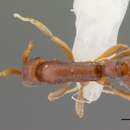en
names in breadcrumbs


Taxonomic history
See also: Eguchi et al., 2006 PDF: 5.(Figs. 7, 9)
Holotype worker: TL 2.7, HL 0.62, HW 0.41 (CI 66), scape L 0.41, WL 0.80, pronotal W 0.33, petiolar node L (from dorsal view) 0.31, petiolar node W 0.23 mm. Lateral petiolar index 83.
Similar to the other Indo-Australian Probolomyrmex , but a little larger and with a more robust body. Posterior corners of head more pronounced, more nearly rectangular, than in related species; posterior border straight, or even feebly convex in full-face view. No eyes detected at 50 X.
In lateral view, the dorsal outline of the trunk is feebly sinuous from about the middle to the propodeal declivity; a slight tumulus marks the apparent position of the scutellum, and the first of 2 faint impressions behind it may represent the metanotal groove. Propodeal teeth fairly prominent, subrectangular, slightly better developed than in the previously described Indo-Malayan species (Taylor 1965: figs. 18, 21, 23).
Petiolar node special in form (figs. 7 and 9), with the sides ending behind in prominent triangular teeth. In dorsal view, the sharp posterior border is broadly excavated, but in the middle, the border shows the merest suggestion of a convexity that could be the vestige of a third tooth, developed to varying degrees in many species of Platythyrea , but not in any other species of Probolomyrmex . The subpetiolar process is like that of P. greavesi , but is even deeper, with the posteroventral corner a little less sharply angled. Postpetiolar (first gastric) segment robust, rounded in front as seen from above.
Exposed parts of palpi as in P. dammermani . Sculpture and pilosity as in other Indo-Australian congeners, but the larger punctures more numerous and more than usually distinct over head, trunk (especially pleura), and petiole; appressed pubescence also fairly distinct over most of body. Color dark ferruginous, legs and antennae a bit lighter, more yellowish.
Holotype a unique taken by Winkler apparatus (sample no. 27) in the Paini Hills, Madras State, India, 10 km NW of Kodaikanal, elevation 2150 m, 15 September 1972 by the team of Besuchet, Loebl, and Mussard of MHN — Geneva, where the type is deposited (Forel Collection).
The species is named for the paired strong teeth or angles of the posterior border of the petiolar node. In Probolomyrmex , such teeth are otherwise found only in P. procne , next described below, and also from the same region of southern peninsular India, but in that species, the node is much longer and has straighter sides, and the subpetiolar process is entirely different.